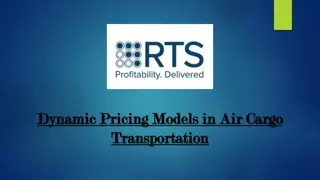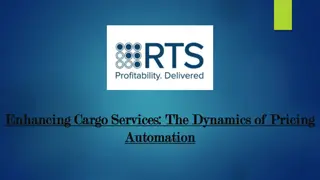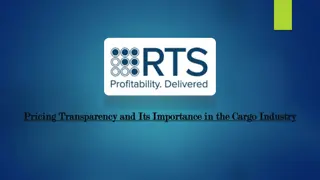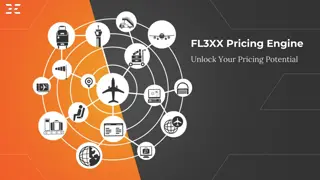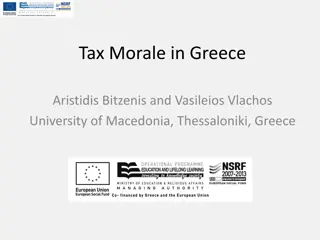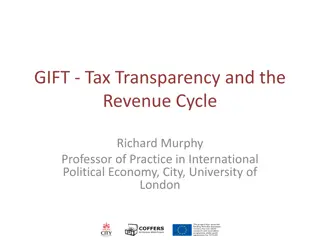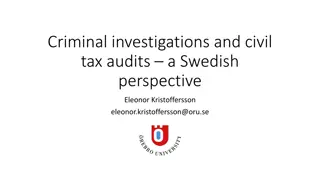Understanding State Transfer Pricing in the Current Tax Landscape
Delve into the intricacies of state transfer pricing with a focus on federal and state regulations, arm's-length pricing, tax evasion prevention, and updates on cooperation initiatives. Explore the significance of intercompany transactions and pricing in today's business environment.
Download Presentation

Please find below an Image/Link to download the presentation.
The content on the website is provided AS IS for your information and personal use only. It may not be sold, licensed, or shared on other websites without obtaining consent from the author. Download presentation by click this link. If you encounter any issues during the download, it is possible that the publisher has removed the file from their server.
E N D
Presentation Transcript
Whats up with State Transfer Pricing? SEATA 2017 NEW ORLEANS
Agenda 1. What is Transfer Pricing? 2. Overview of Federal Transfer Pricing 3. Overview of State Transfer Pricing 4. Update on State Cooperation the Multistate Tax Commission ALAS SITAS Project and beyond 5. OECD BEPS Initiative 2
What is Transfer Pricing? Refers to the mechanism used to establish the arm s-length price of transactions between related entities for goods, intangible assets, services, loans and management fees Designed to prevent tax avoidance by requiring pricing equivalent to prices available with an uncontrolled party Non-arm s length transactions can impact the clear reflection of income across taxing jurisdictions (i.e., internationally, in states where income is reported on a separate or partial combination basis) Tax evasion or avoidance generally not a pre-requisite for application of 482 adjustment 4
Are Intercompany Transactions an Issue for Business? On a major accounting firm s web seminar within the last year, the following polling question was asked of nearly 3,000 participants, Is your enterprise involved in significant intercompany transactions? 5
Are Intercompany Prices Up-to-Date? On another major accounting firm s web seminar the following polling question was asked of roughly 2,000 participants, Where your company has domestic intercompany transactions, how often do you review and update the intercompany prices? 6
Overview of Federal Transfer Pricing Principles 7
Transfer Pricing Authority Federal Background Federal landscape Codified under IRC 482 Extensive regulations, detailed methodologies Developed body of judicial decisions Disciplined procedures for obtaining advance approval for transfer pricing Transactions between affiliated entities can be adjusted to arm s length if necessary to prevent evasion of taxes or to clearly reflect the income of such businesses Statutory language In any case of two or more organizations, trades, or businesses . . . owned or controlled directly or indirectly by the same interests, the Secretary may distribute, apportion, or allocate gross income, deductions, credits, or allowances between or among such organizations, trades, or businesses, if he determines that such distribution, apportionment, or allocation is necessary in order to prevent evasion of taxes or clearly to reflect the income of any of such organizations, trades, or businesses. . . 8
Transfer Pricing Authority Federal Background Concepts Existence of Controlled Transactions Arms length standard IRC 6662 Contemporaneous Documentation Best Method Rule (e.g., resale price method, cost-plus method, comparable profits method (CPM)) - Treas. Reg. 1.482-1(c)(1) Intercompany services: probable benefits test - Treas. Reg. 1.482- 2(b)(2)(i) Advance Pricing Agreements 9
What is the remedy? If the IRS determines that the transfer price of the transaction did not meet the requirements of 482, it can: Propose settlement with taxpayer Adjust the transfer price to reflect the proper cost Make corollary adjustment Impose penalties for gross understatement of income Penalties can amount to 20% or 40% of the difference between the tax paid and the tax owed depending on whether certain thresholds are met 10
Separate Company State Problem and Perspective Complex tax strategies shift income from separate company states to combined return jurisdictions via related-party transactions reducing liabilities in separate company states and not impacting combination states States estimate $100s millions lost revenue annually More complex than 80s/90s intangible holding company and related structures Lack of expertise and/or enforcement at the state level Separate company states should accept transfer pricing responsibilities and administer with competence and reasonableness Transfer pricing is the other side of the combined reporting issue 12
Shifting Income Several types of intercompany transaction can result in the shifting of state income tax liabilities The transfer and licensing of intangible assets The purchase and resale of tangible goods Providing and charging for common services Intercompany financing arrangements Factoring accounts receivables Utilizing embedded royalties 14
Retailer with Purchasing Company Management Management fee fee Parent $$ $$ Widgets Widgets Retailer / Retailer / Taxpayer Taxpayer Purchasing Company $$$$ $$$$ Retailer sells goods with small mark up and breaks even on its tax return after paying substantial management fee to Parent Purchasing sells goods to Retailer at a substantial mark up and reports a majority of the Group s taxable income Parent reports substantial taxable income despite having little in the way of property or employees Taxpayer s transfer pricing study reflects the fact that Purchasing and Parent own the Group s intangibles 15
Manufacturer with Sales Company Parent Parent $ $ $$$$ $$$$ Widgets Widgets Manufacturing Sales Co Sales Co Sales Co sells goods with small mark up and breaks even on its tax return Parent, located in a combined return state, sells goods to Sales at a substantial mark up and reports a majority of the Group s taxable income Manufacturer sells goods to Parent with small mark up and breaks even on its tax return Taxpayer s transfer pricing study reflects the fact that Parent owns the Group s intangibles 16
State Adjustments State transfer pricing landscape varies: Used for Combination Expense/Income adjustments or reattribution Adjustments to international pricing that IRS missed Many states have statutes that adopt or are substantially similar to 482 States may or may not incorporate the federal regulations promulgated under 482 Is that important? Nearly every state adopts some statutory regime to adjust transfer prices of intercompany transactions Some states rely on general conformity to IRC Notable states that do not have statutory regime: Delaware, New Mexico, Pennsylvania 17
State Transfer Pricing Adjustment Authority Example of express 482 adoption (Alabama, Ala. Code 40- 2A-17) (a) In any case of two or more organizations, trades, or businesses . . . owned or controlled directly or indirectly by the same interests, the Commissioner of the Alabama Department of Revenue may distribute, apportion, or allocate gross income, deductions, credits, or allowances, if the Commissioner determines that such distribution, apportionment, or allocation is necessary in order to prevent evasion of Alabama income taxes or to clearly reflect the income of any such organization, trade, or business. (f) The Commissioner . . . shall exercise such authority in a manner consistent with this act and, to the extent applicable, 26 U.S.C. Section 482 and the rulings and regulations issued thereunder. See also Maryland, Md. Code Ann. Tax-Gen. 10-109; Arkansas, Ark. Code Ann. 26-51-805. 18
Recent Cases Rent-A-Center Indiana Rent-A-Center South Carolina See s Candy Utah Taxpayer wins Department could not force combination under 482-like authority Departments of Revenue held to IRS standards Transfer pricing studies found to be persuasive and the Department did not show it was flawed Department must do more than argue it fails the smell test 19
Arms-Length Adjustment Service (ALAS) Project Perceived Need and Program Development The director of the New Jersey Division of Taxation approached the MTC in 2013 about setting up a program States recognized that there are significant issues related to transfer pricing at the state level Most states lack the expertise, resources, and flexibility to staff such a function themselves In December 2013, the Executive Committee authorizes MTC executive director to explore interest among states Project facilitator for a one-year design project hired in March 2014 Advisory Group of states supporting the design project formed by May 2014 ALAS project design approved 2015 Insufficient number of states committed to launch program ALAS replaced with less formal SITAS project 2016 which still serves to promote and facilitate state transfer pricing cooperation 21
Arms-Length Adjustment Service (ALAS) Project Background Design Open and transparent State of the art knowledge from states and experts Executive management perspective: fitting pieces together Long-term resource for several contexts & states Program Features/Elements Interrelated service elements, all mutually supportive Training Analysis of Transfer Pricing Studies State Capacity Building Beyond Training Optional Joint Audits (through Joint Audit Program) Early voluntary disclosure program Taxpayers and states will be encouraged to use the Commission s existing alternative dispute resolution process to resolve issues consistently between a taxpayer and multiple states Advanced Pricing Agreements through existing ADR process 22
State Intercompany Transaction Advisory Service ( SITAS ) and Beyond SITAS Now functioning as informal MTC vehicle to facilitate state cooperation collaboration Encourages ad hoc bilateral / multi lateral cooperation among states to address transfer pricing and other related party transactions issues States working amongst them selves to address issues 23
SITAS Project Commentary and Takeaways 1. Where is it going? 2. Is it necessary and/or beneficial? 3. Will it work? 4. Challenges in implementation and operation? 24
BEPS International Action Plan Base erosion and profit shifting ( BEPS) -globally deployed description for tax planning strategies that rely on mismatches and gaps that exist between the tax rules of different jurisdictions. Organization for Economic Cooperation and Development ( OECD ) is implementing a plan (approved by the G20) which seeks to identify standardized international tax rules to address BEPS. The BEPS Action Plan aims to ensure that profits are taxed where economic activities generating the profits are performed and where value is created. (Source: OECD Action Plan) Three Core Principles Substance - align taxation to value creation Coherence - avoid double non-taxation Transparency - visibility to global information 25
BEPS Actions 9 and 10 - Transfer Pricing Overview Actions 9 & 10, in combination with Action 8, comprise the transfer pricing recommendations They are designed to ensure that profit is realized in accordance to economic substance Key Points Action 8 Intangibles: Purpose is to ensure that profit is aligned to value creation Strict economic substance requirements for attribution of IP driven profits Action 9 TP Aspects of Risk & Capital: Ensures that profit does not accrue to entities solely based on contractually assumed risks or capital Action 10 High Risk Transactions: Addresses other high-risk transactions that may be subject to recharacterization Action 10 addresses low value services Services can be charged only if a benefit inures to the recipient 26
OECD BEPS Project State Implications Proceeding toward global uniform standards are the states aligned? Arm s length standard still prevails Will states respect federal and international transactional analyses? Global mechanisms available for avoiding double taxation (e.g., competent authority) - will states develop a mechanism of their own? Do apportionment methodologies (e.g., market sourcing and single sales factor) distort true jurisdictional profit attribution? vs. international concepts for PE (i.e., nexus) and profit attribution Does BEPS renew interest in worldwide combined reporting? Focus on tax haven legislation? 27



